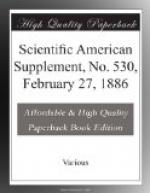In passing to the bleaching and whitening process, it may be necessary to say that thus far the original Thompson process has been entirely altered. Now we come to that part of the bleaching operation where the essential feature in Thompson’s patent is utilized. The patentee has apparently thoroughly grasped the fact that carbonic acid has great affinity for lime and that it liberates, in its gaseous condition, the hypochlorous acid, which bleaches. The most perfect contact is realized between the nascent hypochlorous acid resulting from its action and the fiber constituent in the exposure of the cloth treated with the bleaching solution to the action of the gas. The order of treatment is as follows:
(1) Saturation with weak chemic
(1 deg. Tw.), squeeze,
and
passage to gas chamber.
(2) Wash (running).
(3) Soda scald.
(4) Wash.
(5) Repetition of 1, but with
weaker chemic (1/2 deg. Tw.).
(6) Wash.
(7) Scouring.
The whole of the above operations are carried out on a continuous plan, the machinery being the invention of Mr. Mather. The cloth travels along at the rate of sixty or eighty yards a minute, and comes out a splendid white bleach. The company consider, however, that it is necessary in the case of some cloth to give a second treatment with chemic and gas, each of thirty seconds duration, with an intermediate scald in a boiling very dilute alkaline solution. Mr. Thompson originally claimed that the use of carbonic acid gas rendered the employment of a mineral acid for souring unnecessary. It is considered now to be advisable to employ it, and the souring is included, as will be observed, in the continuous operation.
The new process for treating cloth differs materially from that originally proposed by Mr. Thompson. His plan was to use an air-tight keir in conjunction with a gas-holder. It is obvious that the “continuous” process would not answer for yarns; Thompson’s keir is, therefore, employed for these and all heavy piece-goods.
Thus far I have given a concise outline of the Mather-Thompson process of bleaching, which, it cannot be denied, differs materially from any system hitherto recommended to the trade. Beyond doubt the goods are as perfectly bleached by this process as by any now in use. The question arises, What pecuniary advantage does it offer? Mr. Manby, the manager of Messrs. Ainsworth, has informed me that he has bleached as much as ten miles of cloth by the new process, and is, therefore, entitled to be heard on the subject of cost. In regard to the consumption of chemicals, he estimates the saving to amount to (in money value) one-fourth; steam (coal), one-half; labor, one-half; water, four-fifths; time, two-thirds.
It might be well to contrast the process formerly employed by Messrs. Ainsworth with that they have recently adopted:
“MATHER-THOMPSON” SYSTEM.




